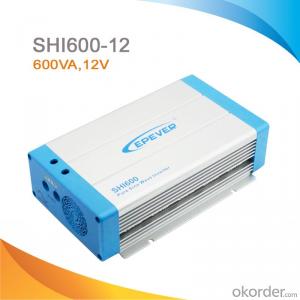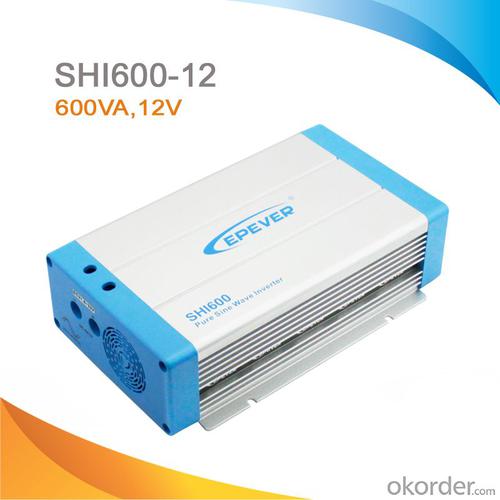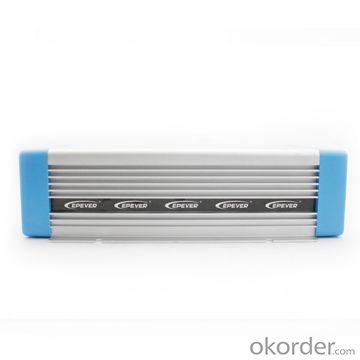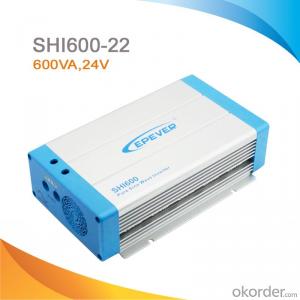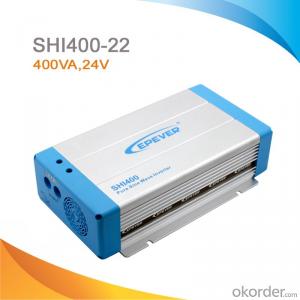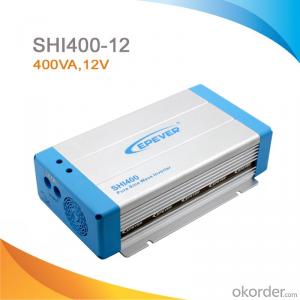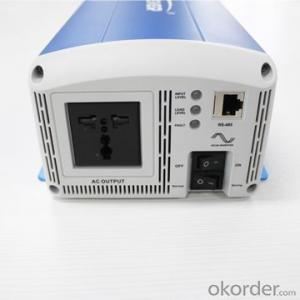20KW Solar Inverter - High Efficiency Off-Grid Pure Sine Wave PV Inverter 600W, DC 12V-AC 220V/230V, SHI600-12
- Loading Port:
- China Main Port
- Payment Terms:
- TT or LC
- Min Order Qty:
- -
- Supply Capability:
- -
OKorder Service Pledge
OKorder Financial Service
You Might Also Like
Description
SHI series is a pure sine wave inverter which can convert 12/24/48Vdc to 220/230Vac 50/60Hz based on full digital and intelligent design. It features high reliability, high efficiency, concise outline, small volume, easy installation and operation. The inverter can be applied in many fields, such as household appliances, electric tools and industrial devices etc, especially for solar photovoltaic power system.
Features:
·Input & output fully isolation
·Adoption of advanced SPWM technology, pure sine wave output
·Dynamic current loop control technology to ensure inverter reliable operation
·Wide DC input voltage range
·The output voltage and frequency can be switched
·Low output harmonic distortion(THD≤3%)
·LED indicators for input voltage range, load power range, normal output & failure state
·Optional energy saving mode
·Wide working temperature range (industrial level)
·Continuous operation at full power
Protections:
·Output short circuit protection
·Overload protection
·Input low voltage protection
·Input over voltage protection
·Overheating protection
·Inverter abnormal protection
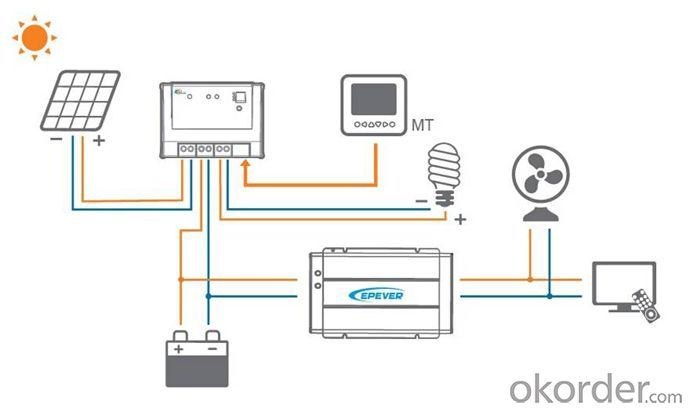
Specification:
Types | SHI600-12 | SHI600-22 |
Nominal Battery Voltage | 12V | 24V |
Input Voltage Range | 10.8~16Vdc | 21.6~32Vdc |
No Load Current | ≤0.7A | ≤0.45A |
Output Wave | Pure Sine Wave | |
Output Voltage | 220Vac±3% / 230Vac±10% | |
Continuous Power | 600W | |
Power 10 sec | 900W | |
Power 1.5 sec | 1200W | |
Surge Power | 1350W | |
Frequency | 50/60Hz±0.2% | |
Distortion THD | ≤ 3% (resistive load) | |
Efficiency at Rated Power | ≥91% | ≥92% |
Max. Efficiency | ≥93% | ≥94% |
Terminal | 25mm2 | |
Dimensions | 295×186×82mm | |
Installation | 150×178mm | |
Hole Size | Φ6mm | |
Net Weight | 2.3kg | |
Working Temperature | -20℃~ +50℃ | |
Storage Temperature | -35℃~ +70℃ | |
Humidity | < 95% (N.C.) | |
Altitude | < 5000m(Derating to operate according to IEC62040 at a height exceeding 1000m) | |
Insulation Resistance | Between DC input terminals and metal case: ≥550MΩ; Between AC output terminals and metal case: ≥550MΩ. | |
Dielectric Strength | Between DC input terminals and metal case: Test voltage AC1500V, 1 minute Between AC output terminals and metal case: Test voltage AC1500V, 1 minute | |
- Q: What is the role of a solar inverter in a solar-powered water purification system?
- The role of a solar inverter in a solar-powered water purification system is to convert the direct current (DC) generated by the solar panels into alternating current (AC) that can be used to power the water purification system. It also ensures the optimal utilization of solar energy by regulating the voltage and frequency of the electricity produced, making it compatible with the requirements of the water purification system.
- Q: How do you calculate the efficiency of a solar inverter?
- To calculate the efficiency of a solar inverter, you need to divide the output power by the input power and multiply the result by 100 to get a percentage. The formula is: Efficiency = (Output Power / Input Power) * 100.
- Q: Can a solar inverter be used in a solar-powered desalination system?
- Yes, a solar inverter can be used in a solar-powered desalination system. A solar inverter is responsible for converting the direct current (DC) electricity generated by solar panels into alternating current (AC) electricity, which is required for the operation of the desalination system. By utilizing a solar inverter, the system can effectively harness solar energy and convert it into usable power for the desalination process.
- Q: Is it possible to upgrade my existing solar inverter without replacing the entire system?
- Yes, it is possible to upgrade your existing solar inverter without replacing the entire system. In some cases, you may be able to replace the inverter with a more advanced model that offers improved efficiency or additional features. However, it is important to consult with a professional to ensure compatibility and proper installation.
- Q: What are the safety features in a solar inverter?
- Solar inverters, also known as photovoltaic (PV) inverters, play a crucial role in converting the direct current (DC) electricity generated by solar panels into alternating current (AC) electricity that can be used to power homes or businesses. In order to ensure the safe and efficient operation of solar inverters, they are equipped with various safety features. One of the primary safety features in a solar inverter is the ground fault protection. This feature is designed to detect any current leakage to the ground, which could indicate a fault in the system. If a ground fault is detected, the inverter will immediately shut down to prevent any potential electrocution hazards. To protect against overvoltage situations, solar inverters are equipped with surge protection devices (SPDs). These devices are responsible for diverting excessive voltage spikes or surges to the earth, thereby protecting the inverter and other connected electrical equipment from damage. In the event of a grid power outage or blackout, solar inverters are equipped with anti-islanding protection. This feature ensures that the inverter automatically disconnects from the grid, preventing any power backfeeding, which could pose a serious threat to utility workers trying to repair the grid. Temperature monitoring is another crucial safety feature in solar inverters. Since inverters can generate heat during operation, they are equipped with temperature sensors to monitor the internal temperature. If the temperature exceeds the safe limit, the inverter will automatically shut down to prevent any potential fire hazards. Furthermore, solar inverters are often equipped with built-in arc fault circuit interrupters (AFCIs). These devices are designed to detect and interrupt dangerous arc faults that can occur due to damaged or deteriorating wiring connections. By quickly stopping the flow of electricity, AFCIs help to prevent electrical fires. Lastly, many solar inverters have advanced monitoring and diagnostic systems. These systems provide real-time data and alerts, allowing users or installers to identify and address any potential safety issues promptly. Overall, the safety features in a solar inverter are crucial in ensuring the safe and reliable operation of the system. These features protect against electrical hazards, prevent damage to the inverter and connected equipment, and contribute to the overall safety of the solar power generation system.
- Q: How does a solar inverter protect against overvoltage?
- A solar inverter protects against overvoltage by continuously monitoring the voltage levels of the solar panels. If the voltage exceeds a certain threshold, the inverter automatically reduces the power output or disconnects from the grid to prevent damage to the system and ensure the safety of the electrical components.
- Q: What is the maximum number of parallel inverters that can be installed in a solar system?
- The maximum number of parallel inverters that can be installed in a solar system depends on various factors such as the capacity of the system, voltage limitations, and the specific requirements of the inverters being used. However, in general, there is no hard limit on the number of parallel inverters that can be installed as long as they are properly designed, coordinated, and meet the system's electrical specifications and safety standards.
- Q: What is the role of a solar inverter in a battery storage system?
- The role of a solar inverter in a battery storage system is to convert the direct current (DC) electricity produced by the solar panels into alternating current (AC) electricity that can be used to power household appliances and charge the battery. It also manages the flow of electricity between the solar panels, battery, and the grid, ensuring optimal utilization of the stored energy and facilitating grid interaction when necessary.
- Q: What is the role of galvanic isolation in a solar inverter?
- The role of galvanic isolation in a solar inverter is to provide electrical safety and prevent potential hazards. It separates the input and output circuits electrically, using transformers or optocouplers, to eliminate any potential voltage differences, ground loops, or electrical noise that could cause damage to the inverter or connected devices. Additionally, galvanic isolation helps to protect against electric shocks and ensures the safety of both the system and individuals working with or around the solar inverter.
- Q: Can a solar inverter be used with thin-film solar panels?
- Yes, a solar inverter can be used with thin-film solar panels. Thin-film solar panels have different electrical characteristics compared to traditional crystalline solar panels, but a suitable solar inverter can be selected to match the voltage and current requirements of the thin-film panels.
Send your message to us
20KW Solar Inverter - High Efficiency Off-Grid Pure Sine Wave PV Inverter 600W, DC 12V-AC 220V/230V, SHI600-12
- Loading Port:
- China Main Port
- Payment Terms:
- TT or LC
- Min Order Qty:
- -
- Supply Capability:
- -
OKorder Service Pledge
OKorder Financial Service
Similar products
Hot products
Hot Searches
Related keywords
